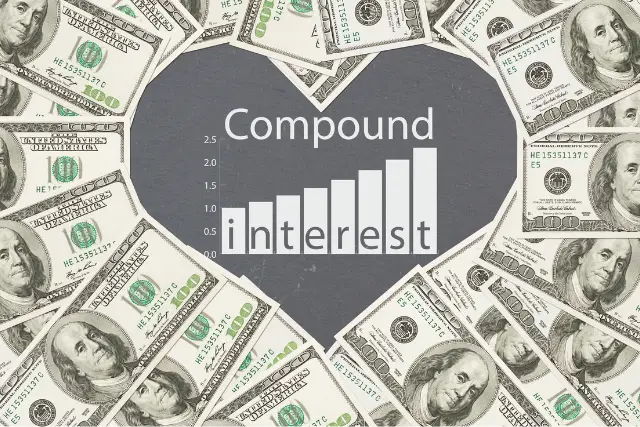You’ve probably heard the term “compound interest” before, but do you know what it actually means? In essence, compound interest results when an investment’s earnings are reinvested so they can earn interest on their own.
The result is a snowball effect that can lead to significantly increased earnings over time. We love compound interest so much because it has allowed us to reach COAST Fire; for more on this story, check out Coast FIRE: The Easiest Way to Join the FIRE Movement.
In this article, we will discuss what compound interest is and how it works. We’ll also look at some examples to help illustrate the concept.
This post may contain affiliate links; please see our disclaimer for details.

Table of Contents
What Is Compound Interest?
Let me explain compound interest by examining how it differs from simple interest.
With simple interest, you only earn interest on the principal or original investment. However, you can calculate compound interest on both the principal and any accumulated past interest. This accrued interest is then added to the principal sum, and the new total becomes the base upon which future compound interest calculations are made.
In other words, compound interest is calculated on both the principal and the accumulated past interest.
Simply put, compound interest is the interest you earn on your initial investment plus the interest you earn on any previous interest that has been added to the account.
Compound interest in retirement planning is important because it can dramatically impact an investment’s growth over time.
Compounding works best when you start early and allow the amount to continue for a long period.
The waiting process takes time. However, the effects are POWERFUL.
Think of compound interest as “interest on interest.”
With compound interest, you earn money on your original investment and the interest that has accrued. The more frequently interest is paid or compounded, the greater the impact on the principal sum.
Where can your money’s interest be compounded?
The most common investment that compound interest works with is a savings account.
The bank pays you interest when you deposit money into a savings account. You can see a payout for the interest typically once per year.
However, some banks offer accounts that compound interest more frequently, such as monthly or daily.
With these types of accounts, the interest in one period adds to the principal sum. You can then calculate the interest for the next period on this new total.
You can also use the formula to assess other assets, such as stocks, bonds, and ETFs. These can be invested in using a brokerage or retirement account.
Although the calculation may be a little off as these asset variables are constantly changing, it can still give you a good idea of what you could expect in the long run.
To summarize, compound interest allows investors to make money by reinvesting their earnings and allowing them to grow over time. This growth can be significant, especially when the account compounds over a long period.
You can even support the compounding effect by including a DCA strategy. In brief, a DCA (dollar-cost-average) strategy is an investment technique in which an investor breaks up a lump sum of cash into smaller investments, buying them over time.
This technique can help reduce the effects of volatility on your investment portfolio and take advantage of market dips to buy assets at a lower price. When combined with compounding, a DCA strategy can profoundly affect your portfolio’s growth.
What Is the Formula for Compound Interest?
We can calculate compound interest using the following formula: A = P(l+r/n)^nt
Variables:
A = the future value of the investment: This is the total amount of money you earn from the investment.
P = the principal investment amount: This is the original sum of money you use to invest.
l = the annual interest rate: The yearly rate at which interest will be earned on the investment.
r = the periodic interest rate: Divide this number by n
n = the number of times that interest compounds per year: This can be monthly, quarterly, semi-annually, or annually.
t = the number of years the money for the investment: This is the length of time that the investment will grow for.
As you can see, several factors go into calculating compound interest. To influence the variables to your favor, focus on finding investments with consistently high-interest rates that compound frequently.
You can also start with a larger principal amount and be willing to wait for more years.
The incredible thing about compound interest is that math accurately predicts how much an investment will be worth in the future.
Compounding is a geometric progression, meaning that each successive year, the interest earned grows faster.
However, the prediction may be wrong only because of human nature. Panic selling, reinvesting at the wrong time, or letting fees eat into returns, can all reduce the final value of an investment.
So, while the math works, other external variables are in your control. Understanding both math and psychology is important to successful compounding.
The formula can be overwhelming to look at. Luckily you do not have to be a math wizard to be able to calculate your potential compound interest. Many online calculators can do the work for you.
In the next section, we’ll simplify the formula with an example of how it works.
How Does Compound Interest Work?
The effect of compounding can be significant. For example, let’s say you have a savings account that pays you simple interest at a rate of five percent per year. After one year, your total balance, including interest, would be $105 (the original $100 plus five percent, or $105).
But if your interest compounds annually–meaning that the interest adds to the account at the end of each year and becomes part of the principal–your balance after one year would be $110.25.
The next year, you would earn interest not only on the original $100 but also on the $105 from the first year, for a total of $110.25. As you can see, compound interest has a snowballing effect and can add up over time!
All in All
Investing works best when it compounds. This is because compounding is a geometric progression, meaning that each successive year, the interest earned grows faster.
Compounding can have a significant effect on the growth of your portfolio. Make sure to keep this in mind when making investment decisions.
The longer you invest, the more pronounced the effects will be. This is why it’s important to start investing early and to have a long-term investment horizon.
Compound interest is often referred to as “the eighth wonder of the world.”
Albert Einstein says it is “the most powerful force in the universe.”
While compound interest can work wonders, it’s important to remember that it is a slow process. The compounding effects are not immediately noticeable, and it can take years for your investments to reach their full potential.
Patience is key when investing, but the rewards can be great if you’re patient and disciplined.
Compound interest is a powerful tool that can help you grow your wealth over time. By understanding how it works and using it to your advantage, you can build a bright financial future for yourself and your family.
It’s never too late to start investing. The earlier you start, the more your wealth will compound!
Disclaimer:
We hope the information in this article provides valuable insights to every reader but we, the Biesingers, are not financial advisors. When making your personal finance decisions, research multiple sources and/or receive advice from a licensed professional. As always, we wish you the best in your pursuit of financial independence!

